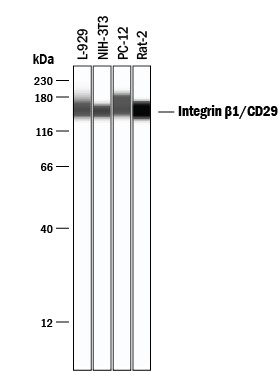Integrins are α/β heterodimeric cell surface receptors that play a pivotal role in cell adhesion and migration, as well as in growth and survival. The integrin family contains at least 18 α and 8 β subunits that form 24 known integrins with distinct tissue distribution and overlapping ligand specificities. Integrins not only transmit signals to cells in response to the extracellular environment (outside-in signaling), but also sense intracellular cues to alter their interaction with the extracellular environment (inside-out signaling).
The β1 subfamily includes 12 distinct integrin proteins that bind to different extracellular matrix molecules. Control of extracellular integrin binding influences cell adhesion and migration, while intracellular signaling messages relayed by the β1 cytoplasmic tail help to regulate cell proliferation, cytoskeletal reorganization, and gene expression. Research studies have implicated β1 integrin in various activities including embryonic development, blood vessel, skin, bone, and muscle formation, as well as tumor metastasis and angiogenesis.
UniProt ID:
P05556
